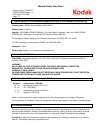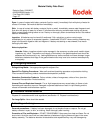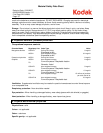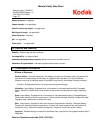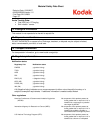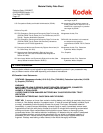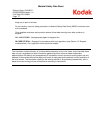
Material Safety Data Sheet
Revision Date: 10/08/2007
000000023093/Version: 1.2
Print Date: 02/13/2009
Page: 2/7
Eyes: In case of contact with battery contents (liquid or metal), immediately flush with plenty of water for
at least 15 minutes. Get medical attention immediately.
Skin: In case of contact with battery contents (liquid or metal), immediately remove metal fragments and
flush skin with plenty of water for at least 15 minutes while removing contaminated clothing and shoes.
Wash contaminated clothing before re-use. Destroy or thoroughly clean contaminated shoes. Get medical
attention immediately.
Ingestion: All batteries may be harmful if swallowed. Call a physician or poison control center
immediately for any actual or suspected ingestion. If swallowed, DO NOT induce vomiting. Batteries may
lodge in the throat or digestive tract and fragment. If battery was leaking or was chewed, rinse mouth
thoroughly with water.
Notes to physician:
Hazards: Battery ingestions should not be managed in the same way as other small metallic object
ingestions, eg., coins. The position and integrity of the battery in the gastrointestinal tract should be
assessed and monitored by x-ray. Leaking batteries may cause necrosis and tissue damage. Larger
batteries or batteries that lodge in the gastrointestinal tract may have to be removed endoscopically
or surgically.
5. Fire-fighting measures
Extinguishing Media: Use appropriate agent for adjacent fire.
Special Fire-Fighting Procedures: Wear self-contained breathing apparatus and protective clothing.
Fire or excessive heat may produce hazardous decomposition products.
Hazardous Combustion Products: Carbon oxides, oxides of manganese, oxides of zinc, (see also
Hazardous Decomposition Products section).
Unusual Fire and Explosion Hazards: Fire or high temperatures may cause battery to flame or leak
flammable and hazardous vapours. Damaged or opened batteries can result in rapid heating and the
release of flammable and hazardous vapours.
6. Accidental release measures
Dispose of in accordance with local regulations (see Section 13. Disposal considerations).
For Large Spills: None should be needed.
7. Handling and storage
Personal precautions: If battery has been damaged, do not breathe fumes or vapours. Do not get
battery contents in eyes, on skin, on clothing. Wash thoroughly after handling.
Prevention of Fire and Explosion: DO NOT DISASSEMBLE. Keep away from heat and flame. Do not
short circuit. Avoid the use of old and new batteries or batteries of varying sizes and types in the same
battery assembly. The batteries electrical characteristics and capabilities may vary and damage may



